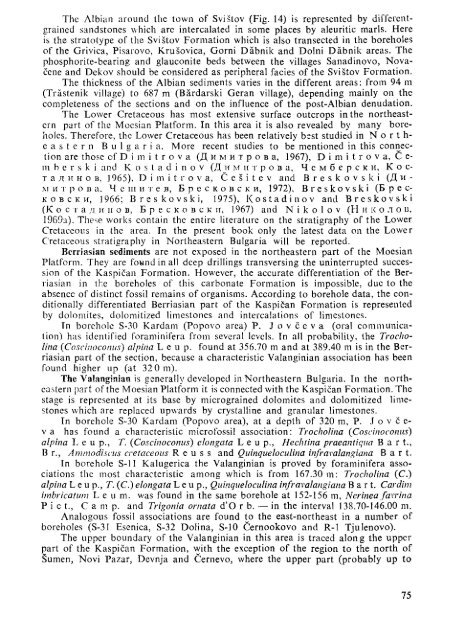THE MEDITERRANEAN LOWER CRETACEOUS
THE MEDITERRANEAN LOWER CRETACEOUS
THE MEDITERRANEAN LOWER CRETACEOUS
Create successful ePaper yourself
Turn your PDF publications into a flip-book with our unique Google optimized e-Paper software.
The Albian around the town of Svistov (Fig. 14) is represented by differentgrained<br />
sandstones which arc intercalated in some places by aleuritic marls. Here<br />
is the stratotype of the Svistov Formation which is also transected in the boreholes<br />
of the Grivica, Pisarovo, Krusovica, Gorni Dâbnik and Dolni Dubnik areas. The<br />
phosphorite-bearing and glauconite beds between the villages Sanadinovo, Novacene<br />
and Dekov should be considered as peripheral facies of the Svistov Formation.<br />
The thickness of the Albian sediments varies in the different areas: from 94 m<br />
(Tïàstenik village) to 687 m (Bârdarski Geran village), depending mainly on the<br />
completeness of the sections and on the influence of the post-Albian denudation.<br />
The Lower Cretaceous has most extensive surface outcrops in the northeastern<br />
part of the Moesian Platform. In this area it is also revealed by many boreholes.<br />
Therefore, the Lower Cretaceous has been relatively best studied in Northeastern<br />
Bulgaria. More recent studies to be mentioned in this connection<br />
are those of D i m i t r о v а (Димитрова, 1967), D i m i t r о v a, Cem<br />
b с г s к i and Kostadinov (Д и м п т р о в а, Чембсрски, Костал<br />
и нов, 1965), D i m i t г о v а, С e s i t e v and Breskovski (Димитрова.<br />
Ч с ш и T e в, Б p e с к о в с к и, 1972), Breskovski (Бреск<br />
о в с к и, 1966; Breskovski, 1975), Kostadinov and Breskovski<br />
(К о с т а д и п о в, Б р е с к о в с к и, 1967) and N i k о 1 о v (H и к о л о в,<br />
1969а). These works contain the entire literature on the stratigraphy of the Lower<br />
Cretaceous in the area. In the present book only the latest data on the Lower<br />
Cretaceous stratigraphy in Northeastern Bulgaria will be reported.<br />
Berriasian sediments are not exposed in the northeastern part of the Moesian<br />
Platform. They are found in all deep drillings transversing the uninterrupted succession<br />
of the Kaspican Formation. However, the accurate differentiation of the Berriasian<br />
in the boreholes of this carbonate Formation is impossible, due to the<br />
absence of distinct fossil remains of organisms. According to borehole data, the conditionally<br />
differentiated Berriasian part of the Kaspican Formation is represented<br />
by dolomites, dolomitized limestones and intercalations of limestones.<br />
Tn borehole S-30 Kardam (Popovo area) P. J о v ce va (oral communication)<br />
has identified foraminifera from several levels. In all probability, the Trocholina<br />
(Coscinoconus) alpina L e u p. found at 356.70 m and at 389.40 m is in the Berriasian<br />
part of the section, because a characteristic Valanginian association has been<br />
found higher up (at 32 0 m).<br />
The Valanginian is generally developed in Northeastern Bulgaria. In the northeastern<br />
part of the Moesian Platform it is connected with the Kaspican Formation. The<br />
stage is represented at its base by micrograined dolomites and dolomitized limestones<br />
which are replaced upwards by crystalline and granular limestones.<br />
In borehole S-30 Kardam (Popovo area), at a depth of 320 m, P. Jove ev<br />
a has found a characteristic microfossil association: Trocholina (Coscinoconus)<br />
alpina Leu p., T. (Coscinoconus) elongata L e u p., Hechtina praeantiqua Bart.,<br />
В г., Animodiscus cretaceous R e u s s and Quinqueloculina infravalangiana Bart.<br />
In borehole S-11 Kalugerica the Valanginian is proved by foraminifera associations<br />
the most characteristic among which is from 167.30 m: Trocholina (C.)<br />
alpina L e u p., T. (C.) elongata L e u p., Quinqueloculina infravalangiana Bart. Cardim<br />
imbricatum Leu m. was found in the same borehole at 152-156 m, Nerinea favrina<br />
P i с t., С a m p. and Trigonia omata d'O г b. — in the interval 138.70-146.00 m.<br />
Analogous fossil associations are found to the east-northeast in a number of<br />
boreholes (S-31 Esenica, S-32 Dolina, S-10 Cernookovo and R-l Tjulenovo).<br />
The upper boundary of the Valanginian in this area is traced along the upper<br />
part of the Kaspican Formation, with the exception of the region to the north of<br />
Sumen, Novi Pazar, Devnja and Cernevo, where the upper part (probably up to<br />
75

















